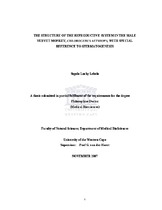| dc.description.abstract | The vervet monkey, Chlorocebus aethiops, an Old World monkey, has been often used in biomedical research programs (toxicological studies and fertility) because of the inaccessibility of relevant human tissues. Data from nonhuman primates have been a vital component of advances in areas such as infertility, contraception, and other reproductive processes because of the phylogenetic closeness of the primates to humans. The aims and objectives of the study were 1) to describe the gross morphology, histology and ultrastructure of the male reproductive system, 2) to describe and compare the processes of spermatogenesis and spermiogenesis of the vervet monkey to humans and other nonhuman primates, and 3) to evaluate the vervet monkey as a possible experimental model for future human reproductive studies. Twenty-nine adult male vervet monkeys, aged between 5 and 11 years, were used. Gross morphological features of different organs of the reproductive tract were recorded. Light and electron microscopic techniques, and methacrylate sections were used on selected tissues of the reproductive tract. The results showed that the vervet monkey has a male reproductive system similar to many non-human primates studied and man. The epididymis was distinctively subdivided into the caput, corpus, and the caudal regions. No significant differences were observed on the epithelial height of these three regions. Four cell types, apical, principal, and basal cells, and the intraepithelial lymphocytes were observed. The basal cell distribution showed significant differences among three regions of the epididymis (P ≤ 0.01). There were numerous phagocytic vesicles found in three regions of the epididymis. The Sertoli cells showed perforated sleeve-like processes which encased elongated and mature spermatids ready for spermiation. The nuclei of the Sertoli cells were found to be multilobed (4 to 5) compared to the less lobular nuclei of the human Sertoli cells (2 to 3). The Leydig cells showed typical features of steroidogenic cells with abundant smooth endoplasmic reticulum, numerous large mitochondria, and few rough endoplasmic reticulum. It was concluded that the gross morphology and structure of the reproductive tract of the vervet monkey has many similarities to humans and other mammals. Secondly, the organization of spermatogenesis is similar to that found in humans, and is commonly known as a helical arrangement. The results further suggest that the vervet monkey could be regarded as suitable model for human male reproductive studies | en_US |

